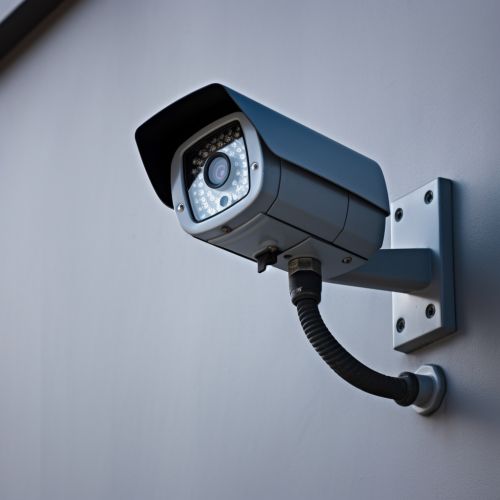Closed-circuit television camera
Overview
A Closed-circuit television camera (CCTV camera) is a type of electronic device used in video surveillance systems. It is designed to monitor and record the activities in a specific area for security, safety, and operational efficiency purposes. The term "closed-circuit" refers to the fact that the video feed from these cameras is transmitted to a specific set of monitors or recording devices, rather than being broadcast openly.
History
The first CCTV systems were developed and installed in the mid-20th century. In the 1940s, the first commercial CCTV systems were installed in Germany to observe the launch of V-2 rockets. In the United States, the first CCTV system was installed by Vericon in 1949. The technology has since evolved significantly, with advancements in digital recording, internet streaming, and artificial intelligence.
Design and Operation
A CCTV camera consists of several key components: the lens, the image sensor, and the image processing circuitry. The lens focuses light onto the image sensor, which converts the light into an electrical signal. This signal is then processed and converted into a video signal that can be displayed on a monitor or recorded for later review.


The lens of a CCTV camera can be fixed or varifocal. Fixed lenses have a set field of view and cannot zoom in or out, while varifocal lenses can be adjusted to change the field of view. Some CCTV cameras also include motorized pan and tilt functions, allowing the camera to be remotely controlled to cover a larger area.
The image sensor in a CCTV camera is typically either a charge-coupled device (CCD) or a complementary metal-oxide-semiconductor (CMOS) sensor. CCD sensors are known for their high image quality and low noise, but they consume more power and are more expensive than CMOS sensors. CMOS sensors, on the other hand, are cheaper, consume less power, and are more common in modern CCTV cameras.
The image processing circuitry in a CCTV camera is responsible for converting the raw data from the image sensor into a video signal. This includes tasks such as demosaicing (converting the sensor's color filter array data into a full-color image), noise reduction, and compression.
Types of CCTV Cameras
There are several types of CCTV cameras, each designed for specific applications and environments:
- Dome Camera: Dome cameras are named for their dome-like shape. They are commonly used in retail environments and other public spaces due to their discreet appearance and wide field of view.
- Bullet Camera: Bullet cameras are long and cylindrical in shape, resembling a bullet. They are typically used in outdoor environments and have a narrower field of view than dome cameras.
- PTZ Camera: PTZ (pan-tilt-zoom) cameras can be remotely controlled to pan (move left or right), tilt (move up or down), and zoom in or out. They are commonly used in large public spaces such as parking lots and shopping centers.
- Box Camera: Box cameras are large and conspicuous, often used in environments where a visible camera presence is desired for deterrence.
- IP Camera: IP (Internet Protocol) cameras transmit video over a network, allowing for remote viewing and recording. They can be either wired or wireless.
- Thermal Camera: Thermal cameras use infrared technology to detect heat and produce images even in complete darkness.
Applications
CCTV cameras are used in a wide range of applications, from home security to traffic monitoring to industrial process control. In security applications, they are often used in conjunction with other systems such as alarm systems, access control systems, and intercom systems. In traffic monitoring, they are used to observe traffic flow, detect incidents, and enforce traffic laws. In industrial applications, they are used to monitor processes, ensure safety, and improve efficiency.
Legal and Ethical Considerations
The use of CCTV cameras raises several legal and ethical issues, particularly in relation to privacy and surveillance. Laws governing the use of CCTV cameras vary widely by country and region, and can include restrictions on where cameras can be installed, how footage can be used, and how long it can be retained. Ethical considerations can include the balance between security and privacy, the potential for misuse of surveillance footage, and the impact of surveillance on societal norms and behaviors.
Future Trends
The future of CCTV cameras is likely to be shaped by advancements in technology and changes in societal attitudes towards surveillance. Potential trends include the increased use of artificial intelligence for video analytics, the integration of CCTV systems with other security and building systems, and the development of privacy-enhancing technologies.
